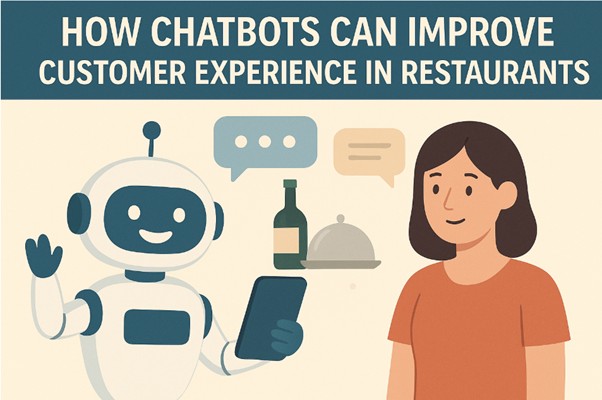
How Chatbots Can Improve Customer Experience in Restaurants
The restaurant industry constantly evolves, and technology is crucial in enhancing customer experience. One of the most innovative advancements in recent years is the integration of chatbots into restaurant operations. These AI-powered assistants can handle reservations, answer customer inquiries, recommend menu items, and even process orders, making the dining experience more seamless and efficient. Chef Shajahan M Abdul, a seasoned expert in the hospitality industry, believes that chatbots are more than just a trend—they are a game-changer in customer service. Drawing on insights from Restro Consultants Pvt Ltd (RCPL) and leading restaurant consultants, this article examines how chatbots can enhance customer experience and why restaurants should adopt them.
The Role of Chatbots in Restaurants
Chatbots utilize artificial intelligence (AI) to interact with customers through messaging platforms, restaurant websites, and mobile applications. They can provide instant support, handle multiple queries simultaneously, and operate 24/7, ensuring a smooth customer interaction without requiring additional human resources.
Chef Shajahan M Abdul says, “Chatbots are revolutionizing how restaurants interact with their customers, providing instant service, reducing workload, and enhancing overall efficiency.”
Benefits of Chatbots in Restaurants
1. 24/7 Customer Support
Unlike human staff, chatbots
are available 24/7 to provide assistance to customers. Whether a diner wants to
check menu options at midnight or make a reservation early in the morning,
chatbots can handle inquiries promptly and efficiently without delay.
Restro Consultants Pvt Ltd
(RCPL) has observed that restaurants implementing chatbot services see a 40%
reduction in missed reservations due to real-time booking confirmations and
reminders.
2. Streamlining Reservations
and Table Management
Managing reservations manually
can lead to overbooking, errors, and customer dissatisfaction. Chatbots can
automate this process by checking table availability, confirming bookings, and
sending reminders to guests.
“With AI-driven chatbots,
restaurants can efficiently manage peak hours, prevent scheduling conflicts,
and ensure a smooth dining experience,” notes Chef Abdul.
3. Enhancing Menu Navigation
and Recommendations
Customers often have specific
dietary preferences or need recommendations when choosing a dish. Chatbots can offer
a personalised experience by suggesting menu items tailored to customer
preferences, previous orders, or current promotions.
Restaurant consultants
emphasize that chatbots with AI-driven suggestions lead to a 20-30% increase in
upselling as they encourage customers to explore more options and add extras to
their orders.
4. Faster Order Processing and
Reduced Wait Times
Long wait times in fast-paced
restaurants can lead to frustration and negative reviews. Chatbots can take
orders directly through messaging platforms, allowing customers to place their
requests before arriving at the restaurant.
Chef Shajahan M Abdul states,
“Integrating chatbots with POS systems reduces order processing time and
enhances kitchen efficiency, ensuring a faster and smoother dining
experience.”
5. Handling Customer Feedback
and Reviews
Customer feedback is crucial
for restaurant growth, but managing reviews manually can be overwhelming.
Chatbots can automate feedback collection by prompting diners to rate their
experience, answer survey questions, and even resolve minor complaints before
they escalate.
Restro Consultants Pvt Ltd
(RCPL) suggests that restaurants using chatbot-driven feedback systems
experience higher engagement and improved customer satisfaction scores.
6. Multilingual Support for
Diverse Customers
For restaurants catering to a
diverse clientele, chatbots with multilingual capabilities offer an inclusive
dining experience. Customers can interact with the bot in their preferred
language, making it easier to understand menu details and place orders.
“Language barriers can
affect customer satisfaction, but chatbots bridge this gap effortlessly,”
explains Chef Abdul.
7. Cost-Effective Customer
Service
Hiring and training customer
service staff can be expensive, especially for small and mid-sized restaurants.
Chatbots help reduce labor costs by automating repetitive tasks, allowing staff
to focus on personalized service and enhancing in-restaurant interactions.
Restaurant consultants note
that chatbot integration can cut customer service costs by up to 30%, making it
a cost-effective solution for restaurant owners.
Challenges of Implementing
Chatbots in Restaurants
While chatbots offer numerous
advantages, restaurants must address some challenges to maximize their
potential.
1. Limited Human Touch and
Personalization
Although chatbots are
efficient, they lack the warmth and emotional intelligence of human
interactions. Some customers may prefer speaking to a live representative,
especially when handling complex requests.
“The key is to balance
automation with personalized human service,” suggests Chef Shajahan M
Abdul. “Restaurants should offer the option to connect with a live agent
when needed.”
2. Technical Glitches and
Misinterpretation
Chatbots rely on AI algorithms,
which may occasionally misinterpret customer queries or fail to provide
accurate responses. Regular updates, AI training, and human oversight are
necessary to maintain chatbot efficiency.
Restro Consultants Pvt Ltd
(RCPL) advises restaurants to conduct periodic reviews of their chatbot
performance to refine responses and improve accuracy.
3. Integration with Existing
Systems
For chatbots to function
effectively, they require seamless integration with point-of-sale (POS)
systems, reservation platforms, and customer relationship management (CRM)
tools. Restaurants may face initial setup challenges, but proper technical
support ensures smooth operation in the long run.
Best Practices for Implementing
Chatbots in Restaurants
To successfully integrate
chatbots into restaurant operations, consider the following best practices:
Conclusion: The Future of
Chatbots in Restaurants
The restaurant industry is
embracing AI-driven solutions, and chatbots are at the forefront of this
transformation. With benefits such as 24/7 customer support, enhanced order
accuracy, and improved customer engagement, chatbots are reshaping the way
restaurants interact with diners.
Chef Shajahan M Abdul states,
“Chatbots are not just a passing trend; they are a strategic investment in
the future of restaurant operations. By combining AI efficiency with human
hospitality, restaurants can provide an exceptional customer experience.”
With guidance from Restro
Consultants Pvt Ltd (RCPL) and expert restaurant consultants, restaurants can effectively
implement chatbots, ensuring improved service, streamlined operations, and
increased customer satisfaction.
Are you ready to transform your restaurant with AI-powered chatbots? Restro Consultants Pvt Ltd (RCPL) can help you find the right solution to enhance your restaurant’s customer experience and operational efficiency. Contact us today to get started!
Chef Abdul © Copyright 2024. All rights reserved.